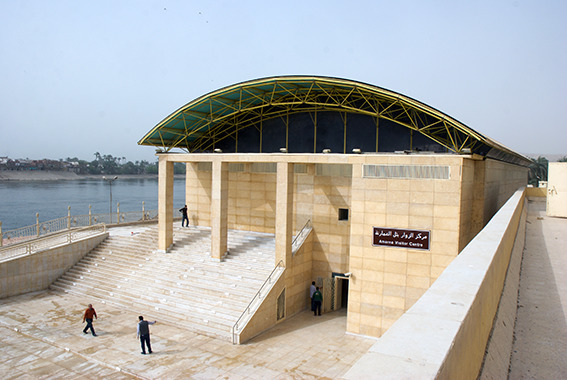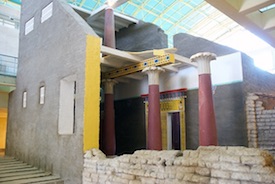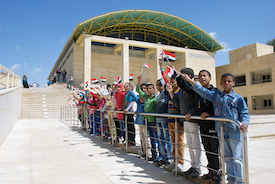The Amarna Visitor Centre
The Visitor Centre in the town of El-Till near the ancient city of Amarna, completed in 2016, is the result of a British-Egyptian research and design collaboration. Archaeologists from the University of Cambridge and the Egyptian Ministry of Tourism and Antiquities curated the content aimed at both national and international visitors, providing visual contextualisation.
As a legacy of the historic fundraising practise of partage, which divided ownership of artefacts between foreign-lead excavation teams and local government, allowing excavators to find sponsors, whether museums or private backers, objects from Amarna have been widely dispersed to museums and private collections. While the presence of objects from Amarna in museums across the world continues to inspire generations of visitors to become fascinated with the Amarna Period and its enigmatic royal family, partage resulted in little being left to be viewed close to the geographic origin of these artefacts.
The exhibits at the Amarna Visitor Centre fill this void by including replicas of monuments and objects from the site held in museums around the world, accompanied by Arabic–English information panels. Detailed scale models of several clusters of building within the historic site provide an archaeological interpretation of the life and buildings of the Ancient City of Akhetaten and help visitors to interpret the city's layout still visible at Amarna today. The centrepiece of the museum is a full-scale cut-away reconstruction of a house of an Amarna official, which visitors can walk through.
For further images of the exhibits at the Amarna Visitor Centre please visit the Centre's Facebook page (Arabic).
The Visitor Centre is open every day from 8:00am to 4:00pm. Tickets for the main monuments must be purchased from the Ticket Office situated on the road to the North Tombs.
Visiting the Amarna Site
A one-day visit to Amarna will allow you to take in most or all of the following highlights (but make sure to arrive early):
- North Palace: One of the best-preserved palaces from ancient Egypt. The lower parts of the walls have been partly rebuilt to help protect the monument and make it understandable to visitors.
- Small Aten Temple: Glimpse the vastness of Akhenaten’s monuments for the Aten at this partially reconstructed temple.
- North Tombs: The elaborately decorated tombs of Akhenaten’s officials are a highlight of any Amarna visit.
- Boundary Stela U: Akhenaten’s vision for the city is inscribed in stone on this striking rock-cut tablet.
- Royal Tomb: Wind your way through the stark Royal Wadi to visit the original resting place of Akhenaten, hidden deep in the eastern cliffs.
A two-day trip will give you more time at the monuments above and allow time to visit the remaining sites (e.g. South Tombs, Kom el-Nana).
Further information to help you prepare for visiting Amarna can be found in the drop-down menu below.
A comprehensive new Amarna Guidebook is in preparation (American University in Cairo Press).
Amarna is located on the east bank of the Nile River opposite the town of Deir Mawwas. Most visitors arrive by car or chartered bus from the Eastern Desert Highway. Take the turn-off to Mallawi. As you drive westwards towards the Nile, the entrance to Amarna is on the left just before crossing the bridge over the river at Deir el-Bersha. You will then enter Amarna via the ancient ‘North City’. If coming from the south, you will enter the site near the South Tombs. If coming from the west bank, Amarna is reached either by the bridge over the Nile between Deir Mawwas and Mallawi, or by ferry crossing.
It is possible to visit Amarna by train or public bus, although this is less straightforward. The arrival station is Mallawi or Deir Mawwas, where it is necessary to hire a local car to bring you to Amarna. Retain the car all day – the site is too large to walk around. Amarna is also a stop on some Nile cruises.
There are no hotels at Amarna itself. Small hotels can be found in the city of Mallawi on the west bank of the river around 20 minutes away and there is a Guest House at Deir Abu-Hinnis on the east bank some 10km north of Amarna. Most visitors, though, stay in the regional capital Minia, about 1.5 hours north of Amarna, where a wide range of hotels is available. Visitors coming from the south may choose to stay in Asyut, which is also around 1.5 hours drive away.
The site is open to visitors every day from 8:00am to 4:00pm. Tickets for the main monuments must be purchased from the Ticket Office situated on the road to the North Tombs.
Amarna has modest tourist infrastructure. There is a visitor Rest House opposite the ticket office which sells drinks. There are also a number of small shops, especially on the drive through the town of El-Till, selling drinks, fruit and snacks. Buying these locally, rather than bringing them in to Amarna, is a great way to support the local economy. Many hotels in the region will provide lunch boxes for day trips upon request. Toilets are available at the Rest House opposite the ticket office and at the Visitor Centre. The Rest House opposite the ticket office also has a small selection of souvenirs for sale.
Visitors with impaired mobility will find Amarna difficult to visit. The surface of the site is largely unpaved desert and there is little shade. The North Tombs and Boundary Stela are accessible only by high staircases without handrails. The South Tombs are not located high in the cliff face, but are quite spread out. The first (Tomb 7) is reached by a short but fairly steep incline. The Royal Tomb involves a descent down a staircase and ramp (both with handrails). The floors inside the rock-cut tombs are often uneven. There is wheelchair access at the Visitor Centre, although not through the reconstructed house.
Don’t forget to bring good shoes and a hat. A torch can also be useful to see details inside the tombs. And please take care of the fragile ruins by not walking or climbing on the remains. Note that it is illegal to remove any ancient materials (including broken pottery shards and fragments of beads) from archaeological sites in Egypt.
The Egyptian Ministry of Tourism and Antiquities provides a useful set of tips and guidelines for visitors.





